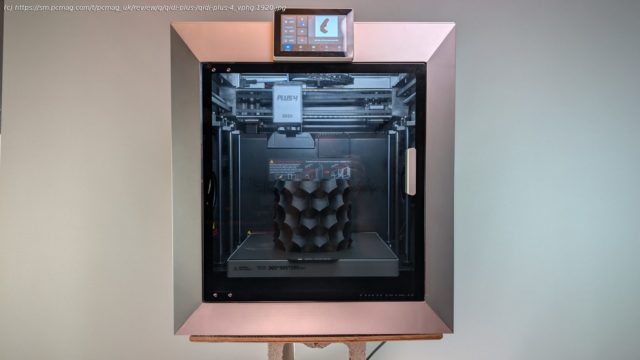This 3D printer can make nearly anything
The Qidi Plus 4’s chamber heating and high-temperature direct drive system set this $799 printer apart from the rest of its midrange competitors. Positioned between Creality’s affordability and Bambu’s innovation, Qidi emphasizes material versatility, consistent print quality, and enclosure-driven performance. While some 3D printing enthusiasts are happy to stop with ASA or ABS filaments—popular units like the Bambu Lab A1 check most of the boxes for most people—others have projects that require higher-quality and more-durable materials like nylon and polycarbonate. For these and several other use cases, the Plus 4 represents an exceptional value and a solid upgrade from the more beginner-friendly A1. It wins an Editors’ Choice award as the best filament-based 3D printer for hobbyists.Qidi History: Advancing the State of the Art
Qidi entered the consumer 3D printing market in 2014, focusing on enclosed, user-friendly FDM printers at a time when most competitors—including Creality—were emphasizing open-frame, DIY-style machines. While Creality gained popularity with its budget-friendly, modifiable Ender series, Qidi built its reputation on plug-and-play reliability and sturdy enclosures, making early models like the Qidi Tech I and X-Pro popular in educational and office environments.
As the industry shifted toward speed, automation, and high-temperature capabilities—especially following Bambu Lab’s 2022 launch of the X1 Carbon—Qidi responded with machines like the X-Plus, X-Max, and ultimately the Plus 4. For a while, I watched this evolution from afar, sticking with my finicky LulzBot TAZ 5 for the better part of a decade. (Oh, the fun of leveling a square bed that has only three leveling screws.but I digress.)
The mechanical engineer in me knew it was time for a new printer, and not an entry-level unit like the Bambu Lab A1 Mini (as venerated and reliable as it is). I wanted something with more ability than that; a class above it. I decided to see if the Plus 4 could fit the bill, and I purchased the unit I’m reviewing here, rather than receiving a loaner from Qidi.Design and Specs: A Large Print Area
The Plus 4 weighs 60 pounds, which is definitely not in the featherweight class. Its footprint is no slouch either, coming in at 19.8 by 19.2 by 21.7 inches (HWD) compared with the Prusa Core One’s 21.8 by 16.3 by 17.5 inches. (The increased size is partly thanks to the steel-frame enclosure.) While I had no problem finding room for the machine—I’ve got a dedicated maker space in my house—users with limited space will find it bulky to move or fit. Qidi compensates for this by building grab handles into the top of the unit, but it can be daunting for a single person to move. I needed my son to help me get it up the stairs.
With a 12-by-12-by-11-inch build area, the Plus 4 supports large prints and multi-part assemblies, ideal for prototyping, making cosplay props, or short-run manufacturing. Dimensionally, the Plus 4 slightly outpaces its closest rivals, the Bambu Lab P1 and X1 Carbon, whose build volumes are 10 cubic inches.
The Plus 4 comes with an active chamber heater, which warms the interior to around 150 degrees F in about 8 minutes when it’s running at 400 watts. (Early firmware versions let the chamber heater pull up to 800 watts, which exceeded the safety ratings of the included solid-state relay [SSR], creating a potential fire risk. While Qidi issued a firmware cap to 400 watts, many users still choose to replace the SSR or install thermal fuses out of caution.)
The heater promotes stable conditions for high-temperature materials like ABS, polycarbonate, and nylon. By circulating heated air throughout the chamber as opposed to passively retaining heat from the extruder or bed in the chamber, parts are surrounded by a uniform temperature, helping to prevent warping and lifting off of the PEI build plate. (Confused by some of this terminology? Check out our guide to 3D printing to learn the basics.)
The Plus 4 also comes standard with a high-temperature direct-drive extruder with a 0.4mm hardened steel nozzle, enabling the use of advanced filaments like polycarbonate, nylon, and carbon-fiber blends, as well as common lower-temperature PLA and TPU. The 80-watt nozzle has a 700-degree-F ceiling with a ceramic heat break to prevent heat creep. The maximum temperature limit means no burnt or malformed nozzle tips, even after printing with filament like polycarbonate.
Qidi uses a 6mm-thick aluminum substrate for the heater bed, a sturdier build than the typical 3mm beds found on entry-level printers. This thickness promotes consistent, even heat across the entire surface. (Notably, the surface is capable of 250 degrees F, well above the requirements of most engineering-grade filaments.) The combination of the thick aluminum heater and effective chamber insulation helps heat soak and the filament maintain stable temperatures, which is crucial for consistent first layers.Unboxing and Setup: Great Attention to Detail
The first thing you’re going to notice when you get the unit is its weight and size. This is one of the most important moments with a new product—how it feels when you take it out of the box. As I touched on above, the unit has thick, sturdy grab handles that are recessed into the frame of the printer. When you pull the machine out and put it on the stand or a nearby table, you know right away it is a heavy, sturdy unit. It feels like it belongs in a factory.
I thought, “Someone is thinking about the little things.”
I connected the filament spool holder, which goes in the rear left corner of the machine. This location makes sense to me, as I could get to it easily and see from a distance how much filament was left on the roll at any given time.
Where placed, the printer felt like a piece of modern furniture. It looks sleek and futuristic, and from a few feet away, you can’t tell that the side panels aren’t aluminum. (You have to touch them to know for sure.) The machine also gets impressively bright via the internal LED; the powerful light makes it easy for my older eyes to work with the unit.
I live with a spouse, who is very concerned about the fumes printers can produce and always quizzes me on my remediation plans. As such, I was happy to see that the chamber fans for the Plus 4 come standard with an active carbon filter pouch. It was just another smart touch that signaled attention to the user experience, and built my confidence in the machine.
I was also very impressed with the guidance of the heated bed assembly. The four 10mm precision-hardened steel rods and two synchronized drive motors told me that Qidi had put a lot of thought into holding the print plane square. At the back of the build chamber, a horizontal stabilizer bar connects the tops of the two vertical Z-axis lead screw assemblies. This acts as a rigid crossbeam between the vertical linear rods and screws that raise and lower the bed across the rear of the printer for additional stability.
The printer walked me through the calibrations on the display, including a bed calibration after the input shaping.
The colorful 5-inch touch-screen display has an 800-by-400-pixel resolution, but it is laggy and unresponsive for a machine of this caliber. It can take several seconds for the preview images of the files you’re loading to fully appear. This is one of the biggest disconnects in the experience, where you feel like the Plus 4 is cutting costs and not fighting in its weight class.
The build plate level variance of my unit was about 0.21mm, which is definitely acceptable out of the box. Using four screws under the bed, you can fine-tune the bed height at the corners, but after printing my first-layer test print (shown below), I decided to use what I had and not adjust anything before getting started.






